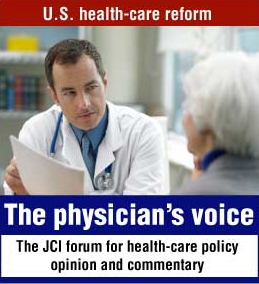Advertisement
Personal perspective Free access | 10.1172/JCI41105
Build it and hope that enough of them will come
Nancy C. Andrews
Duke University School of Medicine, Durham, North Carolina, USA. E-mail: nancy.andrews@duke.edu.
Find articles by Andrews, N. in: JCI | PubMed | Google Scholar
Published September 10, 2009 - More info
J Clin Invest. 2009;119(10):2860–2861. https://doi.org/10.1172/JCI41105.
© 2009 The American Society for Clinical Investigation

There are already too few primary care practitioners in many communities, and the shortage is projected to get worse. I don’t think American medical schools can (or should) increase capacity to turn out enough primary care doctors to fix this problem. Even if classes were dramatically enlarged, there is no guarantee that the added medical students would choose primary care. A better approach would be to redefine the responsibilities of generalist and specialist physicians and allow other professionals — physician assistants, nurses, other extenders — to play bigger roles in delivering and coordinating care. If we are going to solve our future health care needs, medical education will need to do more to prepare students for working collaboratively as members of health care teams. Ideally, students preparing for careers in the various health professions should interact through joint educational experiences that foster mutual respect and understanding. We need to let go of the traditional hierarchy and the view that a physician must always be the person in charge. We should invest in training programs and career development for non-MD practitioners.
Clinical education has been impacted by revving up RVU (relative value units) expectations, regulating resident work hours, and shifting more patient care to ambulatory settings. It is difficult to cram in enough teachable moments and observations of disease progression. Concerns about litigation have led to increased oversight of residents and fellows by attending physicians. For all of these reasons, it takes young doctors longer to become fully trained and independent, which indirectly increases the cost of producing each new physician, both for individuals and for society. I think it’s time to look at this problem in a new way.
One approach might be to reevaluate our one-size-fits-all curriculum. Each student is expected to master a defined body of material in college and in medical school, regardless of whether she or he intends to become a surgeon, a bench scientist, or a pediatrician. I’d like to see thoughtful exploration of alternative models, e.g., partitioning medical education into separate content tracks for surgeons, for generalists, for investigators, and so on. This would be analogous to PhD programs, which require students to differentiate early in their predoctoral education. Recognizing that most students aren’t exposed to behind-the-scenes aspects of medical practice before entering medical school, a new curriculum might start with an introductory clinical experience that allows students to sample different physician careers before committing to a more specialized program. Tracks might begin early in medical school and extend through residency. Such an approach would not only decrease the period of training, but it might also create late-entry and reentry options for those who have delayed or interrupted their professional education because of other life experiences.
These are a few ideas, meant to instigate a more thorough, thoughtful examination. Major changes in training are hard for individual schools to implement unilaterally, because undergraduate medical education, residency, and fellowships are overseen by different accreditation organizations that have different perspectives and goals. But the time seems right for a national discussion, particularly following on a forward-looking report that was recently released by a joint AAMC-HHMI expert committee (1). Describing competencies rather than courses needed by physicians of the future, this report could serve as a cornerstone for rethinking how we educate physicians.
As with health care reform in general, there will undoubtedly be trade-offs. A fresh look at medical education may expose what is bound to be one of many elephants in the crowded room of health care reform — students and their families pay large sums and assume heavy debt to obtain professional credentials to work in the service of society. The personal cost has been accepted in the United States until now, but there may be more pushback if either prestige or potential earnings are diminished. New models for financing the education of health care professionals may ultimately need to be on the table, too, as we think about better aligning incentives for a healthier population.
-
Footnotes
J. Clin. Invest.119:2860–2861 (2009). doi:10.1172/JCI41105.
-
Version history
- Version 1 (September 10, 2009): No description
- Version 2 (October 1, 2009): No description



Copyright © 2025 American Society for Clinical Investigation
ISSN: 0021-9738 (print), 1558-8238 (online)
